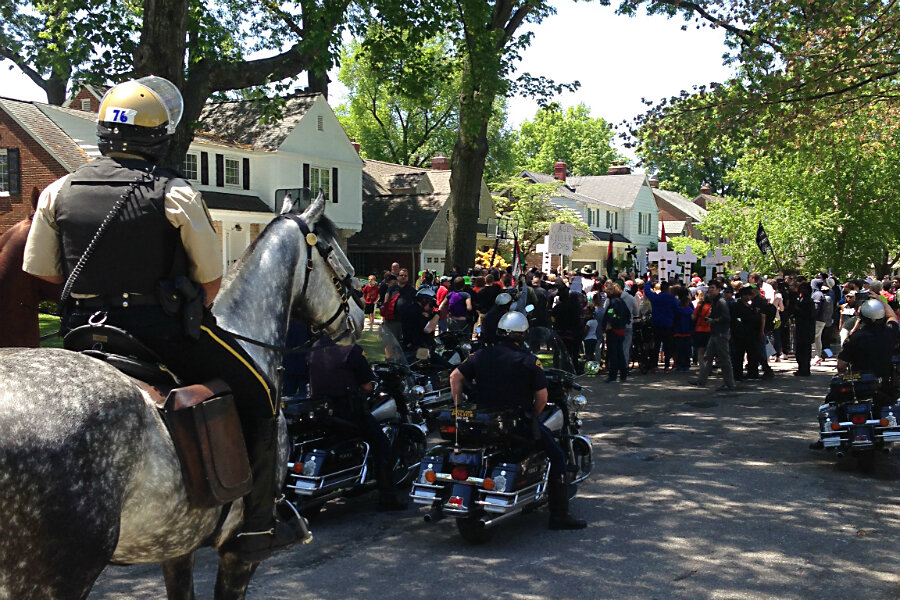Two New Mexico cops to be charged in shooting of homeless man
Loading...
| Albuquerque, N.M.
Two New Mexico police officers will be charged with second-degree murder in last year's shooting death of a homeless man near a tent in the mountains where he had been camping, a special prosecutor said Monday.
James Boyd was killed during a standoff after video showed him appearing to surrender. It sparked angry demonstrations around Albuquerque with protesters calling for reform after several deadly police shootings.
Even before Boyd's death, the Justice Department had been investigating the Albuquerque Police Department over allegations of misuse of force. The DOJ harshly criticized the department this year and has reached an agreement to improve training and dismantle troubled departments.
Other police departments have faced similar DOJ reviews, including the force in Cleveland, Ohio, as The Christian Science Monitor reported.
Following an investigation that began in March 2013, the Justice Department reported [in December 2014] that it has found “a pattern or practice of unreasonable and unnecessary use of force” by the Cleveland Division of Police (CDP).
“We found incidents of CDP officers firing their guns at people who do not pose an immediate threat of death or serious bodily injury to officers or others and using guns in a careless and dangerous manner, including hitting people on the head with their guns, in circumstances where deadly force is not justified,” federal investigators reported. “Officers also use less lethal force that is significantly out of proportion to the resistance encountered and officers too often escalate incidents with citizens instead of using effective and accepted tactics to de-escalate tension.”
But police forces in US cities have also been responding, and making changes.
Broadly speaking, American policing is at a difficult juncture. Under Attorney General Eric Holder, the Department of Justice has written scathing critiques of police culture in cities like Cleveland and Albuquerque, where high-profile shootings have garnered national attention. Meanwhile, the advent of ubiquitous smartphone cameras have given Americansunvarnished glimpses of policing gone tragically wrong.
The Justice Department's Ferguson findings, which allege that a mostly white police force made racist jokes and gave black suspects far less leeway and discretion than white ones, still define many places. Adding to the tension, US police culture is traditionally monolithic and tough to budge, given the solidarity born of the shared experience of facing both mortal dangers and the sometimes impossible and messy tasks appointed to them by the public.
Yet departments that have challenged that culture by changing reward structures, curbing policies that disproportionately impact minorities, and hiring from nontraditional labor pools have seen dramatic results.
On Monday, New Mexico's Special Prosecutor Randi McGinn's office announced several charges against Officers Keith Sandy and Dominique Perez, including second-degree murder, which covers killings that aren't premeditated. It's punishable by 15 years in prison.
Both Sandy and Perez have denied wrongdoing.
Sandy "was protecting a fellow officer when he shot Mr. Boyd," the officer's attorney Sam Bregman said. "There was no criminal intent."
Authorities have said Boyd was schizophrenic and hadn't received proper treatment. He had been holding two knives when he was shot, according to video footage.
The FBI has been investigating, but authorities haven't said whether the officers would face federal charges.
Since 2010, Albuquerque police have been involved in 40 shootings.
Critics have said that's far too many for a city of about 560,000, and Boyd's death in the foothills of the Sandia Mountains provided a flashpoint for frustration.
The protests included a demonstration where authorities fired tear gas and another that shut down a City Council meeting.
McGinn was brought in after the Bernalillo County District Attorney's Office was disqualified after a judge found a conflict of interest.
McGinn's office also will seek voluntary manslaughter, involuntary manslaughter and aggravated assault charges against the officers.
___
Follow Russell Contreras at http://twitter.com/russcontreras







